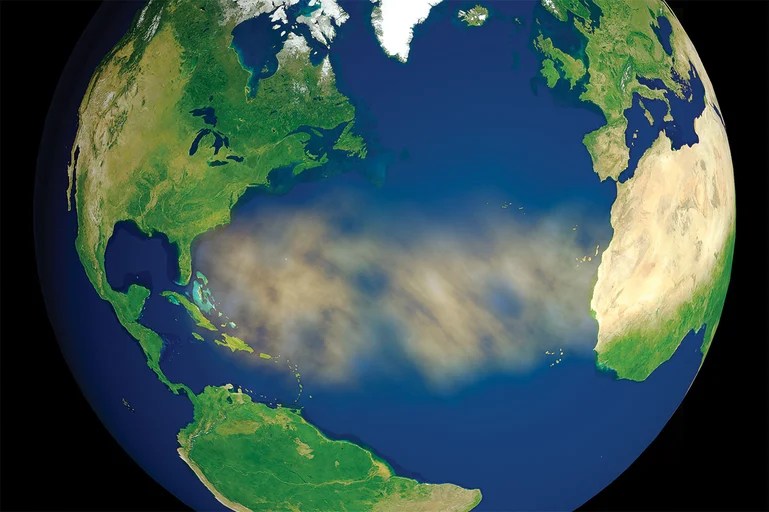We used to scoff at the idea of fertilizing the oceans with iron dumped by ships to reduce carbon dioxide. The last experiment failed miserably. Meanwhile, nature says: “Hold my beer.” From Frontiers of Marine Science This press release was issued by Florida State University.
Marine life thrives thanks to Saharan dust blown in from thousands of kilometers away
The farther away dust-bound iron is blown from the Sahara Desert, the easier it is to be exploited by life through atmospheric reactions..
Iron is an essential micronutrient for life, facilitating processes such as respiration, photosynthesis and DNA synthesis. Iron availability is often a limiting resource in today's oceans, meaning that increased iron influx increases the amount of carbon fixed by phytoplankton, with implications for global climate.
Iron eventually enters marine and terrestrial ecosystems through rivers, melting glaciers, hydrothermal activity, and especially wind. But not all of its chemical forms are “bioreactive,” that is, available for uptake by organisms from their environment.
Dr. Jeremy Owens, associate professor at Florida State University, said: “What we found here is that the properties of the iron contained in dust blowing westward from the Sahara Desert across the Atlantic Ocean change with the distance it travels: the farther away it is, the more iron it contains. , the higher the biological reactivity of iron. Frontiers of Marine Science.
“This relationship suggests that chemical processes in the atmosphere convert less biologically active iron into a more readily available form.”
heart of the matter
Owens and colleagues measured the levels of bioactive iron and total iron in drill cores from the bottom of the Atlantic Ocean collected by the International Ocean Discovery Program (IODP) and its earlier versions. IODP aims to improve our understanding of changing climate and ocean conditions, geological processes, and the origins of life. The researchers selected four cores based on their proximity to the so-called Sahara-Sahel dust corridor. The latter range from Mauritania to Chad and are considered an important source of dusty iron in downwind areas.

The two closest cores to the corridor were collected approximately 200 km and 500 km west of northwest Mauritania, the third was collected in the mid-Atlantic, and the fourth was collected approximately 500 km east of Florida. The authors studied the upper 60 to 200 meters of these cores, which reflect sediments from the past 120,000 years, the time since the last interglacial.
They measured the total iron concentration of these cores, as well as the iron isotope concentrations measured using a plasma mass spectrometer. These isotope data are consistent with dust from the Sahara Desert.
They then used a series of chemical reactions to reveal the proportions of total iron present in the sediments as iron carbonate, goethite, hematite, magnetite and pyrite. The iron in these minerals, although not bioreactive, was likely formed from a more bioreactive form through seafloor geochemical processes.
“Instead of focusing on total iron content like previous studies, we measured iron that is readily soluble in the ocean and available to marine organisms through their metabolic pathways,” Owens said.
“Only a small proportion of the total iron in sediments is bioavailable, but this proportion may change during the transport of iron away from its original source. We aimed to explore these relationships.
blowing in the wind
The results show that the westernmost core has a lower proportion of bioactive iron than the easternmost core. This means that a correspondingly greater proportion of bioreactive iron is lost from the dust and potentially used by organisms in the water column, so it never reaches the sediments at the bottom.
“Our results show that during long-distance atmospheric transport, the mineral properties of the originally non-biologically reactive dust-bound iron change, making it more bioreactive. This iron is then removed by phytoplankton before reaching the bottom. absorption,” said Dr. Timothy Lyons, a professor at the University of California, Riverside and final author of the study.
“We concluded that the dust arriving in areas such as the Amazon and the Bahamas may contain iron that is particularly soluble and suitable for life, thanks to the vast distance from North Africa and therefore longer periods of time,” Lyons said. Exposure to atmospheric chemical processes.
“Transported iron appears to stimulate biological processes, in the same way that iron fertilization affects life in oceans and continents. This study is a proof-of-concept that iron combined with dust can have significant effects on life far from its source.
Relevant
